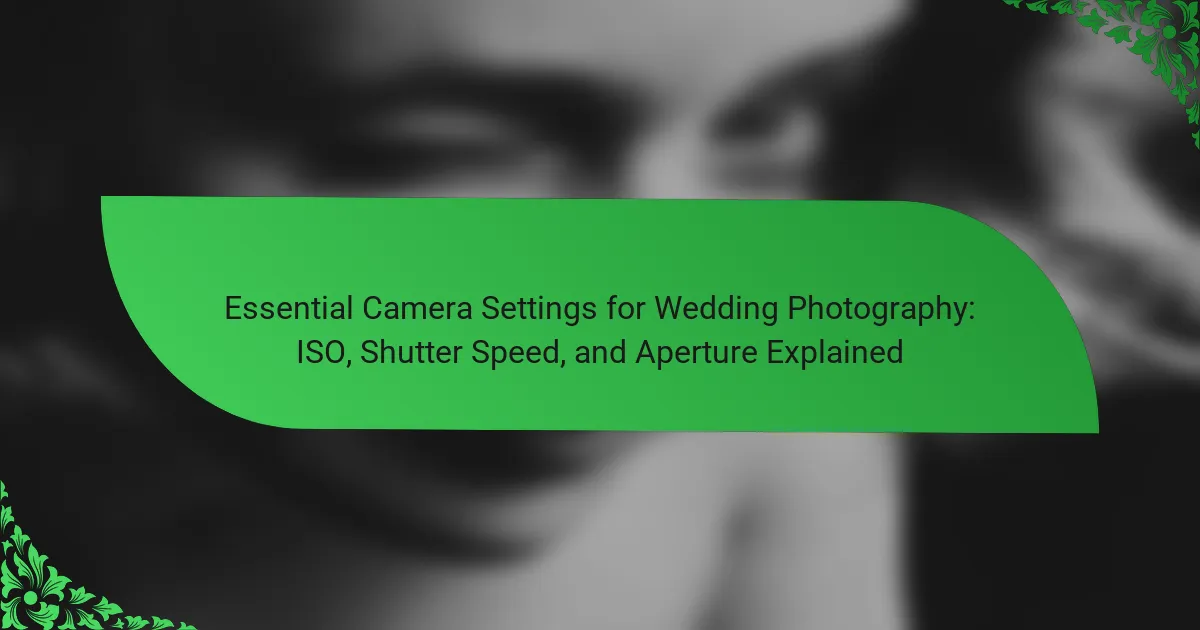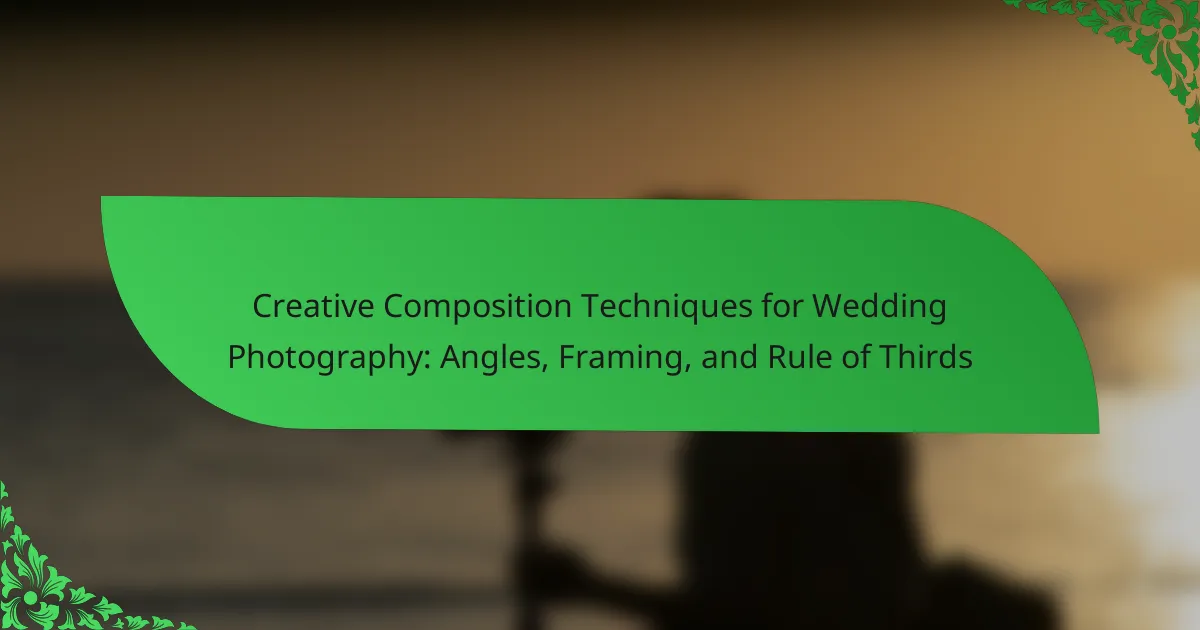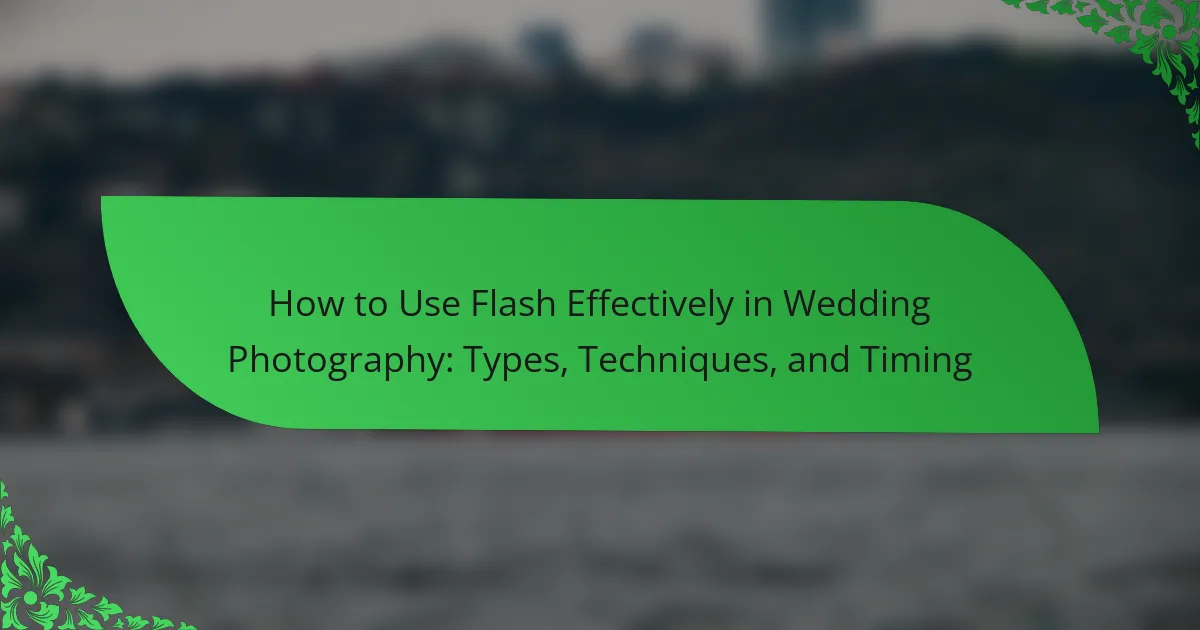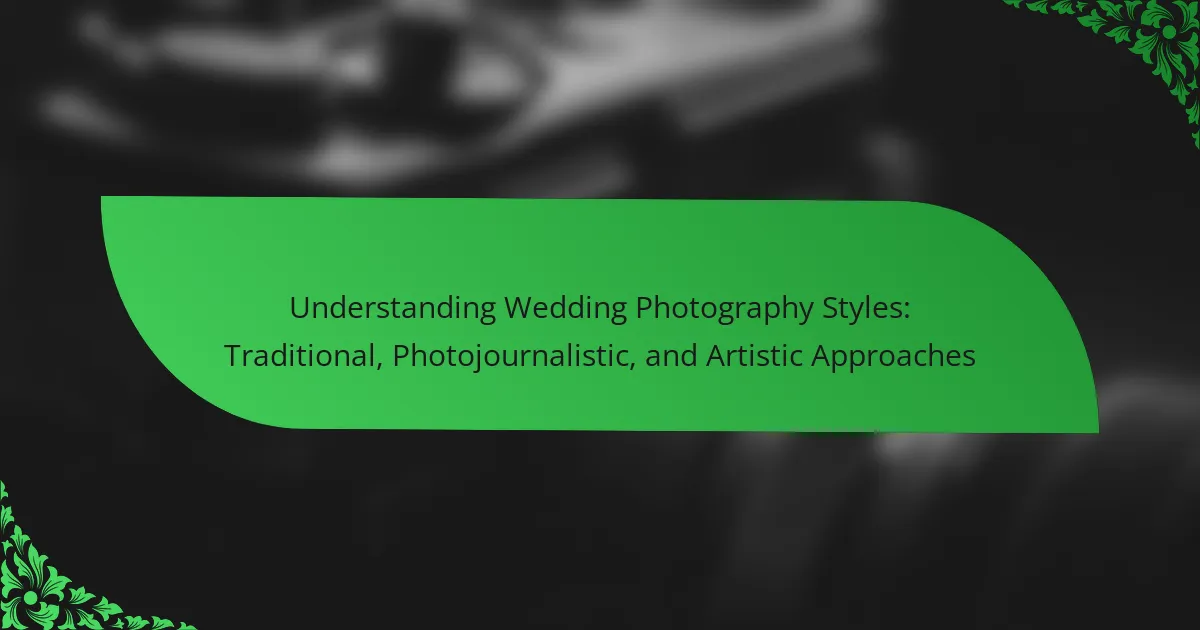Essential camera settings for wedding photography include ISO, shutter speed, and aperture, which are critical for capturing high-quality images in various lighting conditions. ISO determines the camera’s sensitivity to light, with recommended settings ranging from 100 to 1600 depending on the environment. Shutter speed controls the duration the sensor is exposed to light, with a minimum of 1/200 seconds suggested for freezing motion. Aperture influences the depth of field and light entry, with ideal settings between f/2.8 and f/4 for portraits, allowing for creative emphasis on subjects. Understanding and mastering these settings is vital for producing clear, well-exposed photographs that effectively capture memorable wedding moments.

What are the essential camera settings for wedding photography?
The essential camera settings for wedding photography include ISO, shutter speed, and aperture. ISO controls the camera’s sensitivity to light. A higher ISO is useful in low-light conditions, while a lower ISO produces less noise. Shutter speed determines how long the camera’s sensor is exposed to light. A faster shutter speed freezes motion, which is crucial for capturing moving subjects. Aperture affects the depth of field and the amount of light entering the lens. A wider aperture creates a blurred background, emphasizing the subject. For wedding photography, a common ISO setting is 100-800, shutter speed should be at least 1/200 seconds, and an aperture of f/2.8 to f/4 is often ideal for portraits. These settings help ensure clear, well-exposed images in various lighting conditions.
How do ISO, shutter speed, and aperture work together in photography?
ISO, shutter speed, and aperture work together to control exposure in photography. ISO measures the sensitivity of the camera sensor to light. A higher ISO allows for better performance in low-light conditions but can introduce noise. Shutter speed determines how long the camera’s shutter remains open. A faster shutter speed freezes motion, while a slower speed can create motion blur. Aperture controls the size of the lens opening. A wider aperture allows more light and creates a shallow depth of field, while a narrower aperture lets in less light and increases depth of field. Together, these settings balance exposure, allowing photographers to achieve the desired effect in various lighting conditions. For instance, in a dimly lit wedding venue, a photographer might increase the ISO, use a wider aperture, and select a slower shutter speed to capture sharp images without flash. This combination is essential for successful wedding photography.
What is ISO and how does it affect exposure?
ISO is a measure of a camera sensor’s sensitivity to light. Increasing the ISO value allows for better performance in low-light conditions. However, higher ISO settings can introduce noise, reducing image quality. Conversely, lower ISO values result in clearer images but require more light for proper exposure. For example, an ISO of 100 is ideal for bright conditions, while ISO 1600 is suitable for dim environments. This relationship between ISO and exposure is crucial for achieving the desired brightness and clarity in wedding photography.
How does shutter speed influence motion capture in wedding photography?
Shutter speed significantly influences motion capture in wedding photography. A faster shutter speed freezes motion, capturing sharp images of moving subjects. This is crucial for dynamic moments like dancing or candid interactions. For example, a shutter speed of 1/500 seconds effectively freezes fast movements. Conversely, a slower shutter speed creates motion blur, which can convey a sense of movement. For instance, a shutter speed of 1/30 seconds may blur the background while keeping the subject sharp. Photographers must balance shutter speed with lighting conditions to achieve desired effects. Properly adjusted shutter speed enhances storytelling in wedding photography by emphasizing key moments.
What role does aperture play in depth of field and light intake?
Aperture controls both depth of field and light intake in photography. A wider aperture (lower f-stop number) allows more light to enter the camera. This results in a brighter image. It also creates a shallower depth of field, which blurs the background and emphasizes the subject. Conversely, a narrower aperture (higher f-stop number) lets in less light. This produces a darker image and increases depth of field, keeping more of the scene in focus. The relationship between aperture, light intake, and depth of field is fundamental in achieving desired photographic effects.
Why is it important to understand camera settings for wedding photography?
Understanding camera settings is crucial for wedding photography. Proper settings ensure optimal exposure, sharpness, and color accuracy. Weddings often involve varying lighting conditions, from bright outdoor scenes to dimly lit receptions. Mastery of ISO, shutter speed, and aperture allows photographers to adapt quickly. For instance, a low ISO minimizes noise in low-light situations. Adjusting shutter speed prevents motion blur during dynamic moments. Correct aperture settings achieve desired depth of field, isolating subjects beautifully. These technical skills enhance the overall quality of wedding images. Consequently, photographers can capture memorable moments with precision and artistry.
How can mastering these settings enhance the quality of wedding photos?
Mastering camera settings such as ISO, shutter speed, and aperture significantly enhances the quality of wedding photos. Proper ISO settings reduce noise and improve image clarity, especially in low-light conditions typical of weddings. Adjusting shutter speed captures motion effectively, ensuring sharp images of dynamic moments like dancing or walking down the aisle. Aperture control influences depth of field, allowing for beautiful background blur that emphasizes the couple and their emotions. Together, these settings enable photographers to adapt to varying lighting conditions and capture the essence of the event. For instance, using a low ISO and wide aperture in dim venues can lead to stunning, well-lit portraits.
What common mistakes do photographers make with camera settings?
Photographers often make several common mistakes with camera settings. One mistake is using an incorrect ISO setting. A high ISO can introduce noise, while a low ISO may not capture enough light. Another mistake is improper shutter speed. A speed too slow can result in motion blur, while a speed too fast can freeze action unnecessarily. Additionally, photographers frequently misjudge aperture settings. A wide aperture can lead to a shallow depth of field, while a narrow aperture may not allow enough light in. Many photographers also forget to adjust their settings based on changing lighting conditions. This can lead to overexposed or underexposed images. Lastly, not utilizing the camera’s histogram can result in poor exposure decisions. Understanding these common errors can significantly improve photographic outcomes.
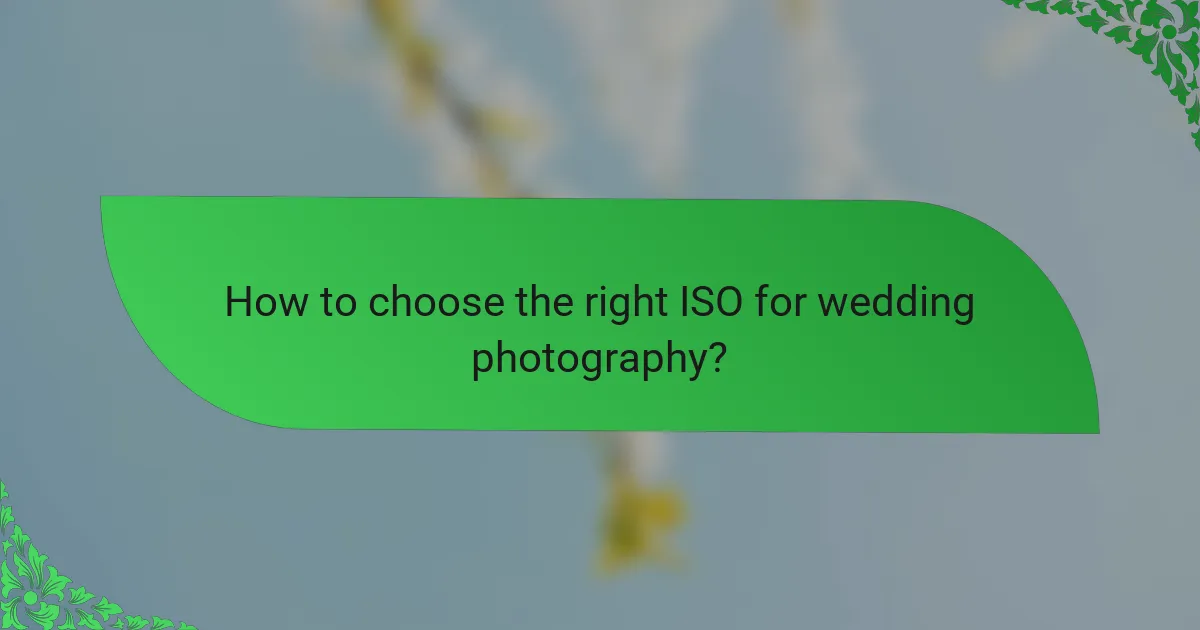
How to choose the right ISO for wedding photography?
To choose the right ISO for wedding photography, consider the lighting conditions. In bright daylight, set the ISO to 100 or 200 for optimal image quality. In shaded areas or during sunset, increase the ISO to 400 or 800 to maintain proper exposure. For low-light environments like indoor receptions, an ISO of 1600 or higher may be necessary. Higher ISO settings can introduce noise, so find a balance between sensitivity and image clarity. Use your camera’s histogram to check exposure levels. Adjust the ISO as needed while keeping shutter speed and aperture in mind to achieve the desired effect.
What factors should influence your ISO selection during a wedding shoot?
Lighting conditions should influence your ISO selection during a wedding shoot. In low-light environments, a higher ISO allows for better exposure. Conversely, in bright settings, a lower ISO minimizes noise and preserves image quality. The type of venue also matters; indoor spaces often require higher ISO settings than outdoor locations. Action and movement during the ceremony or reception can necessitate a faster shutter speed, which may require adjusting the ISO accordingly. The desired depth of field can affect ISO; a wider aperture may allow for lower ISO settings. Understanding the camera’s performance at different ISO levels is crucial. Cameras typically perform better at lower ISO settings, reducing graininess in images.
How does lighting condition affect your choice of ISO?
Lighting conditions directly influence your choice of ISO in photography. In bright lighting, a lower ISO setting, such as 100 or 200, is sufficient. This helps maintain image clarity and reduce noise. In low light situations, a higher ISO, like 800 or above, is necessary to capture more light. Increasing ISO allows for faster shutter speeds, preventing motion blur. However, higher ISO settings can introduce noise, impacting image quality. Therefore, balancing ISO with available light is crucial for optimal exposure.
What are the implications of using high vs. low ISO settings?
Using high ISO settings increases sensitivity to light but introduces noise. Low ISO settings reduce noise but require more light for proper exposure. High ISO can be beneficial in low-light situations, allowing faster shutter speeds. However, noise can degrade image quality, particularly in shadow areas. Low ISO produces cleaner images with better detail and color accuracy. The trade-off between ISO settings significantly impacts exposure, image quality, and overall aesthetic.
How does shutter speed selection impact wedding photography?
Shutter speed selection significantly impacts wedding photography by controlling motion blur and exposure. A fast shutter speed freezes action, capturing sharp images of dynamic moments, such as dancing or candid interactions. Conversely, a slower shutter speed can create intentional motion blur, adding a sense of movement to images.
In wedding photography, lighting conditions vary greatly. In bright environments, faster shutter speeds are necessary to prevent overexposure. For dimly lit venues, slower shutter speeds might be required, but this increases the risk of motion blur if not stabilized properly.
The choice of shutter speed also affects the depth of field indirectly through its interaction with aperture settings. A balanced approach ensures that both the subject and background are appropriately exposed and in focus.
Ultimately, understanding shutter speed allows photographers to creatively capture the essence of the event while ensuring technical quality in their images.
What shutter speed is ideal for capturing fast-moving moments?
A shutter speed of 1/500th of a second or faster is ideal for capturing fast-moving moments. This speed effectively freezes motion, reducing blur in dynamic scenes. For even faster subjects, such as athletes or vehicles, consider using 1/1000th of a second or faster. High shutter speeds minimize the effects of camera shake and subject movement. Many professional photographers use these settings to ensure clarity. This technique is crucial in wedding photography, where moments can happen quickly. Proper lighting conditions may also influence the choice of shutter speed. In bright environments, higher shutter speeds are easily achievable.
How can you prevent motion blur in your wedding images?
To prevent motion blur in wedding images, use a fast shutter speed. A shutter speed of 1/200 seconds or faster is ideal for capturing moving subjects. Increasing the ISO setting can help achieve faster shutter speeds, especially in low light. Additionally, using a wider aperture allows more light to enter, facilitating faster shutter speeds. Stabilizing your camera with a tripod or using image stabilization can also reduce blur. Lastly, anticipate movement and shoot at the right moment to enhance clarity.
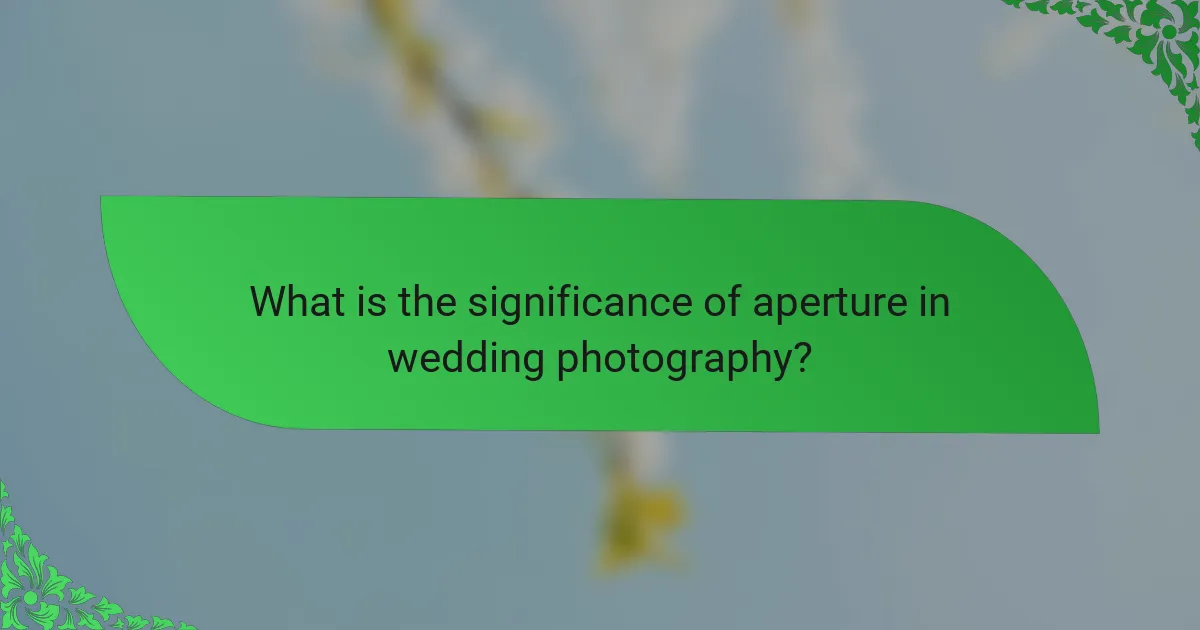
What is the significance of aperture in wedding photography?
Aperture is crucial in wedding photography as it controls the amount of light entering the camera. A wider aperture (lower f-stop number) allows more light, ideal for low-light settings like receptions. This results in brighter images and can create a shallow depth of field. A shallow depth of field emphasizes the subject by blurring the background. Conversely, a narrower aperture (higher f-stop number) reduces light and increases depth of field. This is useful for group shots or landscapes. Adjusting aperture impacts exposure and artistic style. Mastering aperture enhances creative control in capturing memorable wedding moments.
How does aperture affect the overall look of wedding photos?
Aperture significantly impacts the overall look of wedding photos. It controls the amount of light entering the camera and influences depth of field. A wide aperture (low f-stop number) creates a shallow depth of field. This results in a blurred background, emphasizing the subject. It enhances portraits by isolating the couple from distractions. Conversely, a narrow aperture (high f-stop number) increases depth of field. This keeps more elements in focus, ideal for group shots or scenic backgrounds. The choice of aperture directly affects the mood and aesthetics of the images. For example, wide apertures often convey intimacy, while narrow apertures can evoke a sense of space.
What are the creative effects of using a wide aperture?
Using a wide aperture creates a shallow depth of field. This effect isolates subjects by blurring the background. It enhances the focus on the main subject, making it stand out. Wide apertures also allow more light into the camera. This is beneficial in low-light situations, producing brighter images. Additionally, they can create a pleasing bokeh effect. Bokeh refers to the aesthetic quality of the out-of-focus areas. It adds a dreamy, artistic touch to photographs. Photographers often use wide apertures for portraiture and macro photography. These settings help achieve a more intimate and engaging composition.
How does a narrow aperture contribute to image sharpness?
A narrow aperture increases image sharpness by reducing the amount of light entering the camera. This results in a greater depth of field. A greater depth of field allows more elements in the scene to be in focus. Typically, apertures like f/8 or f/11 are used for optimal sharpness. At these settings, lens aberrations are minimized. Consequently, images exhibit less blurriness and greater detail. This is particularly beneficial in wedding photography, where capturing intricate details is essential. Studies show that sharpness peaks around these narrower aperture settings, enhancing overall image quality.
What tips can help photographers effectively use camera settings during weddings?
Photographers can effectively use camera settings during weddings by understanding and adjusting ISO, shutter speed, and aperture. A low ISO setting (100-400) is ideal for bright conditions, while higher settings (800-3200) may be necessary for low light. Shutter speed should be fast enough to freeze motion, typically 1/200s or faster for moving subjects. Aperture affects depth of field; a wider aperture (f/2.8-f/4) creates a blurred background, ideal for portraits. Photographers should also use manual mode to have full control over these settings. Additionally, using exposure compensation can help manage tricky lighting situations. Practice with different settings before the event can enhance confidence and adaptability.
How can you quickly adjust settings in changing lighting conditions?
To quickly adjust settings in changing lighting conditions, use the camera’s exposure triangle: ISO, shutter speed, and aperture. Increase ISO to enhance sensitivity to light without altering shutter speed or aperture. Adjust shutter speed to control motion blur; faster speeds freeze action, while slower speeds allow more light. Change aperture to modify depth of field and light intake; wider apertures let in more light. Utilize your camera’s automatic modes or exposure compensation for rapid adjustments. Consistently monitor the histogram to ensure proper exposure. These methods allow immediate adaptation to varying light environments.
What best practices should be followed for optimal results in wedding photography?
To achieve optimal results in wedding photography, photographers should focus on preparation, communication, and technical settings. First, conduct a detailed pre-wedding consultation with the couple. This helps establish expectations and preferences. Second, scout the venue beforehand to identify the best shooting locations. Good lighting is crucial, so plan around natural light availability. Third, use appropriate camera settings. A common recommendation is to set a low ISO for bright conditions and adjust the shutter speed to avoid motion blur. Aperture settings should be wide for portraits and narrower for group shots. Fourth, maintain clear communication with the couple and guests during the event. This ensures everyone is aware of key moments. Lastly, have backup equipment ready to avoid technical failures. Following these practices can significantly enhance the quality of wedding photographs.
The main entity of this article is the essential camera settings for wedding photography, specifically focusing on ISO, shutter speed, and aperture. The article provides a detailed explanation of how these settings work together to control exposure and capture high-quality images in varying lighting conditions. Key topics include the impact of ISO on image clarity, the role of shutter speed in freezing motion, and how aperture affects depth of field and light intake. Additionally, it addresses common mistakes photographers make with these settings and offers practical tips for optimizing results during wedding shoots.
